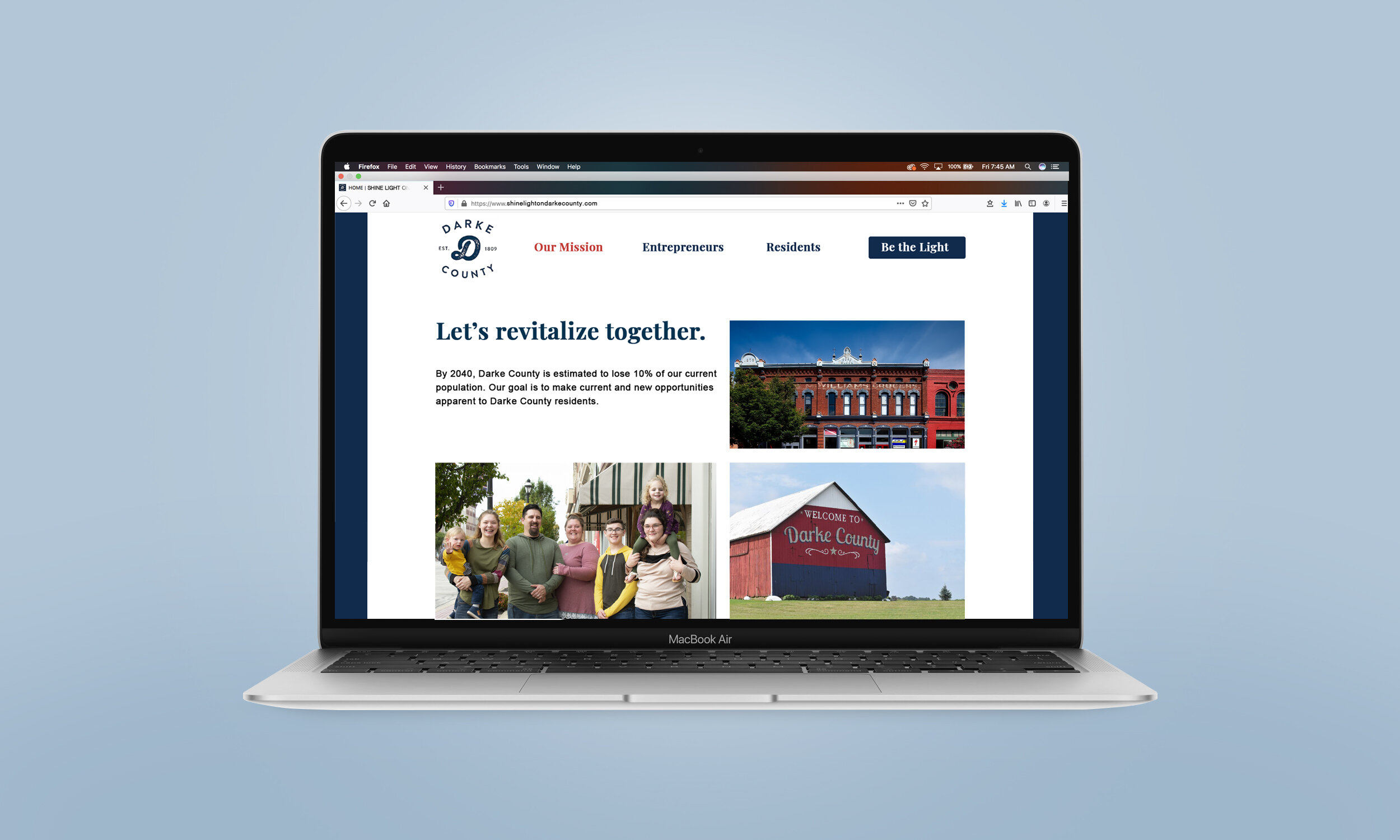Darke County Revitalization
In 2010, the United States Census released Darke County’s new demographics and released further projections in 2018. From 2000 to 2010, the county suffered over a 1% decrease in population. This may not seem like a lot, but that is a 2,000 persons decrease. In the year 2040, Darke County population is estimated to have 46,280 residents. That’s a significant drop from their current estimated population of 51,734. Why is Darke County losing population at this rate? How can Darke County prevent this population decrease from happening? Darke County’s older generations, who are part of the majority, are depleting, and the younger generation is moving outside of Darke County.
Project Outline
CLIENT OVERVIEW
Darke County, Ohio made its debut in 1809 and has valued small town traditions ever since. Its historical value made Darke County an interesting and inspired place to live: known for the Treaty of Versailles, birthplace of Annie Oakley, the location of the infamous Great Darke County fair, and even rarity landmarks such as Bears Mill. Darke County prides itself on small town country living and interpersonal relationships through small business encouragement, especially within the manufacturing, healthcare, and agriculture industries. They use sources to support to the community, but there is a disconnect between the information and Darke County residents, as well as a disconnect between residents and Darke County itself. The 2000–2010 population decrease, the 2018 projections, and the 2040 population estimates are concerning Darke County leaders, causing them to wonder the cause and how to prevent these events from happening even further.
TARGET AUDIENCE
Residents of Darke County, surrounding areas who do business with the county, and Darke County leaders are all stakeholders in this process. These stakeholders will all be positively influenced by these marketing efforts to advertise this problem and empower the community to develop solutions themselves.
PROJECT GOALS
The goal is to retain Darke County’s population. To do this, intensive market and ethnographic research was implemented to develop tangible data of why and what was causing this county emigration. Design solutions are dependent on past and current residents of Darke County and their problems. The design solutions are solved by the audience's preferred way of communication.
Research
SECONDARY RESEARCH
This case study was built on secondary and primary research. The goal was to discover a problem based on several themes within numerous sources, such as the US Census, Darke County’s website, or other local websites.
There were three possible problems I could have focused on:
1. How to make Darke County’s towns collaborate together.
2. Women’s salaries in Darke County are 40% lower than men’s. Why?
3. How do we make Darke County’s brand inclusive for all towns within it?
Although these problems were valid, they were not wicked or the absolute source of a problem. Further investigation of the Darke County Census and one-on-one interviews revealed that population decrease was the main concern/problem that Darke County is facing.
PRIMARY RESEARCH
I interviewed five Darke County leaders to understand possible causes to population decrease and whether it was a common concern among all leaders. In conclusion, nearly all Darke County leaders said the cause of further population decrease is due to younger generations leaving the Darke County area to:
1) Pursue other job opportunities
2) Find better education
3) Improve their quality of life
SURVEY
There were 70 respondents in the survey. I conducted a survey to past and present Darke County residents. These questions tested their level of awareness and use of local resources and general thoughts of the county. This survey took numerous routes depending on the respondent’s answers, and the results confirmed my suspicions.
Here’s the facts that stuck out:
33% of residents do not use local resources, like Hometown Opportunity.
28% of residents said Darke County would not grow.
26% of past residents say there’s no entertainment in Darke County.
The main reason why past Darke County residents left is for college education and job opportunity.
The Problem
CONCEPTUAL MODEL
There is an obvious disconnect between what leaders are providing and what residents are receiving. This model states three reasons why Darke County’s population is decreasing: a perceived lack of 1) Diversity, 2) Opportunity, and 3) Quality of Life.
SOLUTION STATEMENT
Darke County is working to improve residents’ concerns, but there is no central communication channel between the younger generations and the county. Darke County needs to attract the younger generation by strictly advertising the benefits and improvements of Darke County through use of preferred media, while developing new, original proposals for change.
Ideation
PLANS OF ACTION
Darke County Revitalization has (3) Parts:
1. Awareness Campaign
2. Business Development
3. All Inclusive, Entertainment Campaign
The Darke County Chamber of Commerce, Visitor’s Bureau, and Darke County Economic Development must collaborate and work together to incite and advertise these initiatives through resident’s preferred media.
Motion Advertisement
This motion advertisement summarizes all infographics into one. The video is meant to be inspiring, persuasive, and understanding.
3 Infographics
These infographics integrate the population problem, survey information, current opportunities that Darke County offer, and new proposals for change.
Marketing Campaign
These deliverables encompass the downtown renovations ads, grant promotions, and website.



Want to See More?
Read more about the in-depth marketing strategy within the Darke County Revitalization case study.











